Mastering The Toddler Transition: Top Tricks To Turn Toilet Training Into Triumph
Toilet training is a significant milestone in a toddler's life, marking a step towards independence and maturity. For parents, it can be both an exciting and daunting experience. The transition from diapers to the toilet requires patience, understanding, and a strategic approach. This article explores 10 effective tricks to make this process smoother and more successful. Each section delves into a unique aspect of toilet training, providing insights and practical tips to transform this challenging phase into a triumph. By understanding the nuances of toddler behavior and development, parents can guide their children through this critical transition with confidence and ease.
1. Understanding Readiness: The First Step

Before embarking on the toilet training journey, it's crucial to assess your toddler's readiness. Children develop at their own pace, and forcing toilet training too early can lead to frustration for both the child and the parent. Look for signs such as showing interest in the bathroom habits of others, staying dry for longer periods, or expressing discomfort with dirty diapers. These indicators suggest that your toddler might be ready to begin toilet training. Understanding these signs can prevent unnecessary stress and create a positive environment for learning. It's essential to remember that readiness is not solely about age but about physical, emotional, and cognitive development.
2. Creating a Positive Environment: Setting the Scene

A supportive and encouraging environment is vital for successful toilet training. Create a space where your toddler feels comfortable and safe. Introduce a child-friendly potty chair that is easily accessible. Personalize the potty with your child's favorite stickers or colors to make it more appealing. Additionally, keep the bathroom stocked with essentials like wipes and extra clothes. Establishing a routine can also help; choose specific times during the day for potty breaks, such as after meals or before bedtime. Consistency and familiarity will help your toddler feel secure and more willing to participate in the process.
